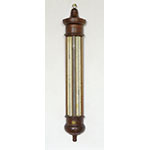Maximum and minimum thermometer invented by James Six and built by Antonio Matteucci for the Museo di Fisica e Storia Naturale. Mounted on a semicylindrical wooden column with a profiled top and bottom, it is composed of a central vessel filled with alcohol, connected to a U-tube. The alcohol is used as thermometric liquid, while the mercury serves as an indicator. The indicators placed on the mercury surfaces consist of iron needles inserted into small blue glass tubes fitted with a thin elastic metal wire. As the alcohol expands and contracts, the mercury moves the indicators. These are wedged in the thermometric tube by the metal, and thus record the maximum and minimum temperatures reached. To bring them back into contact with the mercury, they are simply dragged back into the capillary tube by means of a magnet. The Réaumur and Fahrenheit scales, drawn on strips of paper, are protected by thin glass plates.









